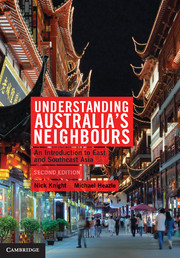Book contents
- Frontmatter
- Contents
- List of Maps
- Acronyms and abbreviations
- Acknowledgments
- Maps
- Introduction
- 1 The idea of ‘Asia’
- 2 Tradition and modernity in East and Southeast Asia
- 3 Tradition and modernity in East and Southeast Asia
- 4 Colonialism in East and Southeast Asia
- 5 Nationalism and revolution in East and Southeast Asia
- 6 Nations and nation-building in East and Southeast Asia
- 7 International politics and East and Southeast Asia
- 8 Economic growth in East and Southeast Asia
- 9 Democracy, human rights and development
- 10 Globalisation and East and Southeast Asia
- 11 China–Japan relations and US power in the twenty-first century
- 12 Australia in Asia, ‘Asia’ in Australia
- Bibliography
- Index
- References
3 - Tradition and modernity in East and Southeast Asia
Religion
Published online by Cambridge University Press: 05 June 2012
- Frontmatter
- Contents
- List of Maps
- Acronyms and abbreviations
- Acknowledgments
- Maps
- Introduction
- 1 The idea of ‘Asia’
- 2 Tradition and modernity in East and Southeast Asia
- 3 Tradition and modernity in East and Southeast Asia
- 4 Colonialism in East and Southeast Asia
- 5 Nationalism and revolution in East and Southeast Asia
- 6 Nations and nation-building in East and Southeast Asia
- 7 International politics and East and Southeast Asia
- 8 Economic growth in East and Southeast Asia
- 9 Democracy, human rights and development
- 10 Globalisation and East and Southeast Asia
- 11 China–Japan relations and US power in the twenty-first century
- 12 Australia in Asia, ‘Asia’ in Australia
- Bibliography
- Index
- References
Summary
IN THE PREVIOUS CHAPTER, we examined the concept of tradition and compared it to the idea of modernity. We suggested that it was useful to think about tradition in relation to community, and in particular the notion that in a traditional society people had a much stronger bond of affinity to place and family than they do in modern society. Pre-modern societies were based on agriculture, and most people lived in villages with little contact with the outside world. There was little mobility, either geographically or socially. People lived and died in the village and class into which they had been born. Traditional societies therefore tended to be rather static, although not completely unchanging. Patterns of behaviour – rituals, customs, the habits of daily life – were passed on from one generation to the next, and things were done in a particular way for the simple reason that they had always been done that way. Behaviour became habitual. The lack of outside influences strengthened the force of habit that was a hallmark of traditional societies. Modernisation, industrialisation and urbanisation changed the structure and function of the family. In particular, the extended family and stem family gave way to the nuclear family; people gained greater choice in the selection of their marriage partner; families became smaller; and the role of women changed (although more so in some societies than others). In some complex, developed societies with ageing populations, such as Japan, South Korea and Australia, the nuclear family is now in decline, its central position eroded by an increase in single-person households and single-parent families.
- Type
- Chapter
- Information
- Understanding Australia's NeighboursAn Introduction to East and Southeast Asia, pp. 42 - 60Publisher: Cambridge University PressPrint publication year: 2011



